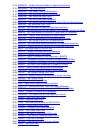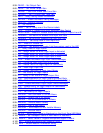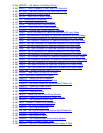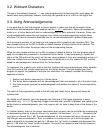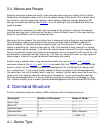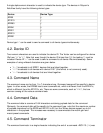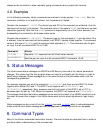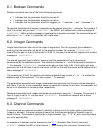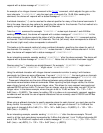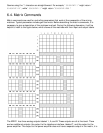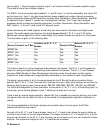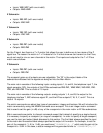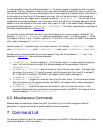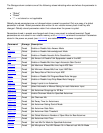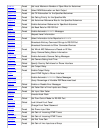
6.1. Boolean Commands
Boolean commands take one of the three following arguments.
● '0' indicates that the parameter should be turned off.
● '1' indicates that the parameter should be turned on.
● '2' indicates that the parameter should be toggled (i.e., '0' becomes '1' and '1' becomes '0').
Parameters associated with boolean commands can be queried using the '?' character. For example, if
input A is muted, and you send ' S04MUTEIA? ', the EF2211 will respond with a status message of '
S04MUTEIA1 '. When a status message is generated for a boolean command, the command data will
either be a '0' or '1', since '2' is obviously not a valid state.
6.2. Integer Commands
Integer commands can take one of two types of arguments. The first argument type is absolute,
meaning that the parameter will be set to the specified number. For example, ' S04GAINIA10 '
means that the gain on input A will be set to 10 dB. In this case, the device will respond with a status
message of ' S04GAINIA10 '.
The second argument type is relative, meaning that the parameter will be incremented or
decremented by the specified amount. The increment character is '>' and the decrement character is
'<'. For example, ' S04GAINIA>3 ' increments the gain on input A by 3 dB. If the input's gain was
previously set to 6 dB, then it would now be set to 9 dB. In this case the device would respond with a
status message of ' S04GAINIA9 '.
The numeric part of both the absolute and relative arguments can contain a '+' or '-' to indicate the
algebraic sign of the argument. If no sign is given, '+' is assumed.
The parameters associated with integer commands have maximum and minimum values associated
with them. If you try to set a parameter above its maximum or below its minimum, the parameter will
be set to its maximum or minimum value, respectively.
Parameters associated with integer commands can be queried using the '?' character. For example, if
input A 's gain is set to 12, and you send ' S04GAINIA? ', the device will respond with a status
message of ' S04GAINIA12 '.
6.3. Channel Commands
A command can be a channel command in addition to being one of the other types of commands
(integer or boolean). A channel command means that the command applies to a specific input or
output channel. The channel is specified by a single character (e.g., '1', 'A', 'B', etc.) occurring before
any other payload data.
An example of a boolean channel command is the '
AGC' (Automatic Gain Control) command. '
S04AGC10 ' disables the AEC on input channel 1 . After sending this command, the device will



